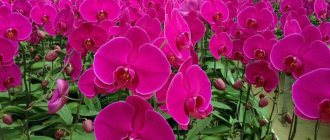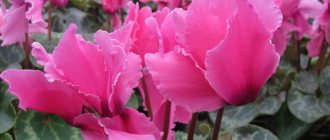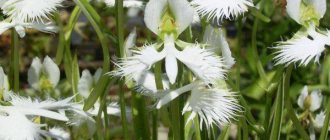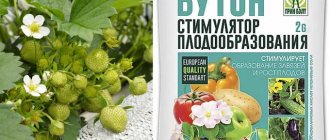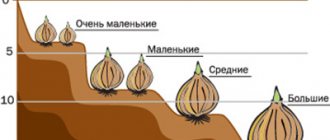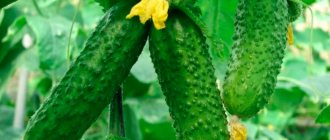The more magnificent and large-scale the flower, the brighter and more beautiful the flowerbed looks, especially if not just one representative, but the whole flowerbed is terry. Color, size and shape fade into the background when the “full” buds appear in front of you, which is what the terry plants are famous for. It is the internal density with an abundance of petals that can make a magnificent flower from an ordinary, not too attractive inflorescence, which significantly increases its significance and scope of use. We offer an original selection of plants with varieties that are so beautiful in their range of terry that they definitely deserve special attention.
Terry tulips
The classic version of tulips is a bud consisting of 5-6 petals, which initially have a closed shape, but when the day comes and the sun warms up, it opens successfully and closes at night. The advantage of double tulip varieties is the abundance of petals. Many people, looking at double tulips, think that this is a rose, although it is just a double tulip, but very beautiful. In addition to the abundance of petals, it should be noted that terryness can manifest itself more literally; on each petal along its entire perimeter there are small hairs that add splendor to the bud. They can be the same color as the petals, slightly shading the main tone of the flower, or white, to significantly emphasize the unusualness of the varieties. The popularity of just such tulips for cutting is enormous, because presenting a bouquet of double tulips is not only to please, but also to surprise.
Varieties of double tulips: Toronto Double, Brest, Drumline, Mascotte, Matchpoint, Queensland, Brooklyn, La Belle Epoque, Vogue, Uncle Tom, Mondial, Dreamtouch, Golden Nizza, Purple Tower, Rococo Double.
Types of Gloxinia
The subshrub or perennial herb is a representative of the Gesneriaceae family; it thrives in the deciduous forests of Peru, in the rocky areas of Mexico, in the Andes, and grows in pots on the windowsill.
The tropical guest turned out to be hardy and undemanding to care. In some species of gloxinia the stem rises to a height of 70 cm, in others it does not exist at all, and the shoots spread along the ground.
A rosette of velvety leaves of a dark green color stands out above the ground surface. They are oval in shape and pointed at the ends.
Gloxinia blooms for about 3 months , in March it produces bells, the diameter of each of them is from 8 to 12 cm. At least 8 buds are formed on one plant, sometimes their number amounts to 3 dozen.
White, crimson, purple or red petals on the corolla are arranged in rows. Flowers covered with villi are monochromatic; there are bells with stripes, borders, specks, double and smooth.
There are more than 20 plant species in the wild; various hybrid varieties have been bred from just two. Gloxinia Beautiful has a tall stem with original leaves, with a pattern of veins appearing on them. Bells come in a variety of colors - from white to purple and violet.
On the shoots of a small bush of Royal Gloxinia there are leaves covered with silvery fibers. Buds form on long peduncles; when they bloom, they reach 7 cm.
Double daffodils
The popularity of double daffodils is so great that the classic varieties not only fade against their background, but also become practically unclaimed. The lush core, different shades and unique beauty of the tandem are an incredible sight. Yellow and white, orange and with a slight red – everything your heart desires. Shades can be rich and bright, or more delicate, pastel. Tandem or monotony are the individual characteristics of each variety.
Varieties of double daffodils: Sweet Pomponette, Calgary, Heamoor, Calgary, Acropolis, Delnashaugh, Full House, Obdam, Rip Van Winkle, Atholl Palace, Unique, Manly, Sweet Pomponette, Westward, Candy Princess, White Marvel, Cheerfulness.
Planting Tips
Clematis of the third pruning group are easily propagated by cuttings. But in order for the bush to develop well, it is necessary to choose the right place for planting. Most of all, clematis like to grow in sunny places, but they can also be kept in partial shade. They will feel good in full shade, but in this case they will not please you with their flowering. When planting clematis in a sunny area, it is advisable to make sure that their “legs” are hidden in the shade. To do this, you can plant low annual plants at the base of the bush.
Avoid planting clematis in open, heavily windy areas. Wind causes irreparable damage to the plant. And also there is no need to plant clematis in places where water stagnates: in lowlands, near drains. Clematis lives a long time: 25–30 years, so the choice of a site for planting must be approached with the utmost care. You can plant clematis throughout the season, but it is best to do this in the spring so that the plant has time to take root and subsequently overwinter well.
Popular articles Construction of a pond from butyl rubber
For each clematis, you need to dig a planting hole 50 centimeters deep and wide. Place a layer of broken brick, pebbles or expanded clay at the bottom of this hole, thereby providing the plant with drainage. As mentioned above, clematis do not like constant soil moisture, so the soil mixture must be prepared especially carefully.
Plant, carefully straightening the roots. The root collar must be sprinkled with sand to prevent rotting. Clematis must be planted with a slight depth (up to 15 centimeters) for the subsequent formation of a lush bush, as well as to prevent winter freezing and summer overheating. When planting several seedlings, the distance between them should be no more than one meter.
Terry amaryllis or hippeastrum
It is this plant that can show that terry is present not only in the flower garden in the open ground, but also in apartments, on our window sills. This is a bulbous plant, which is often called the house lily, since the external data of the inflorescences are very similar. The inflorescence appears from an arrow, which the plant shoots out several times a year. There can be up to four inflorescences per flowering. Terry representatives of amaryllis are very beautiful, because in addition to the standard arrangement of petals like lilies, they are complemented by a beautiful and lush center of smaller petals. The final result looks not only beautiful and unusual, but also very rich.
Varieties of double amaryllis : Jewel, Marylin, Amadeus Candy, Aquaro, Bright Nymph, Striped Amadeus, White Nymph, Exotic Peacock, Lady Jane, Double Record.
Home care
In order for Amaryllis Nymph to feel comfortable at home and delight with its lush flowering, it is better to provide it with a windowsill on the south-east or south-west side and provide the plant with bright, diffused light.
Air humidity should be about 50%, and the temperature should not exceed 23°C.
The plant does not tolerate stagnant moisture in the roots. Watering 1-2 times a week is fine. Do not pour water on the bulb. It is better to water in a tray or on the ground closer to the walls of the pot.
At the bottom of the pot, you must make a decent drainage layer of 30–40 cm. The plant requires nutritious soil. Fertilizing with liquid fertilizers is carried out once every 30 days.
Amaryllis blooms for 15–20 days. The best time to force the plant is considered to be from December to April. If you change the date of planting the bulbs, you can adjust the flowering time. There is no need to replant the bulbs every year. Once every three years is enough.
At the end of flowering, watering is gradually stopped. After the plant sheds its leaves and peduncle, it is removed to a dark, cool place (not lower than 10°C).
The plant bulb must be left at rest for at least 3 months for the plant to gain strength again.
Amaryllis propagates by bulbs or seeds. The second method is more complex and time-consuming. You need to manually pollinate the pistil of one flower with pollen from another. In about 30 days, the seeds will ripen and need to be planted in the ground. In a month, seedlings will appear and are planted in separate pots. Such plants will bloom in about five years. Baby bulbs grow to flowering in a couple of years.
Please remember that amaryllis bulbs are poisonous! The poison is also contained in the leaves and stems. Therefore, it is better to work with the plant with gloves.
Terry hyacinth
It is unlikely that we have seen such a beautiful, lush and voluminous hyacinth, since terry not only transforms, but also significantly modifies the plant. The structure of the plant itself and the formation of inflorescences consists of a candle shape, where a huge number of small inflorescences of the same color make up a magnificent, beautiful picture. What about the doubleness of each small inflorescence in a flower - the beauty is indescribable. The splendor of the thick hyacinth increases significantly, presenting an incredibly beautiful sight - very beautiful.
Terry hyacinth varieties: Spring Beauty, Snow Crystal, Holly Hock, Prince of Love, Red Diamond, Rosette, Manhattan, Royal Navy, Blue Tango.
Reviews from flower growers
Anzhelika, 36 years old, Moscow
I really love terry petunias; I always grow them myself from seeds. The seedlings usually all survive, but at most 1-2 sprouts may die. True, the flowers do not always correspond to the declared characteristics; sometimes they turn out semi-double or even simple. Last year I bought Duo Blue, the flowers turned out really lush, just like on the packaging. I kept the bushes on a heated balcony, and they bloomed until the very end of November, although towards the end they were already weaker than in the summer.
Veronica, 40 years old, Kurchatov
The flowers are beautiful, but rather capricious. I planted Pirouette Parple seeds, the shoots did not appear for quite some time, and only three shoots survived from one package. We initially wanted to plant them in a flowerbed, but then we decided not to risk it and left them at home. There is little trouble with an adult plant, just watering. The flowers are actually very lush, large and spectacular - this cannot be taken away from the variety.
Olga, 25 years old, Ekaterinburg
For four seasons in a row I have been planting petunias of the Double Cascade variety. Not all seedlings survive, so I usually buy three bags at once. The first days when shoots appear, I try to illuminate them around the clock. The bushes are compact, I grow up to a maximum of 20 cm, while the flowers are large, almost the size of a peony, and stay on the bushes for a very long time. In extreme heat they give off a tobacco smell, but these are minor things. I plant them in a flowerbed and they hold up well. One time in the fall, I didn’t bother to remove the wilted flowers; several plants then grew by self-sowing, but there were only two double ones among them.
Terry peony
Peony is considered one of the most recognizable and familiar double plants, since it is its lush center that is the norm to which everyone is accustomed and proudly admires. A wide palette of shades, full, with a huge number of petals inside, which form a voluminous ball, as well as bent petals back.
Varieties of double peonies : Amabilis, Mothers Choice, Kansas, Many Happy Returns, Red Charm, Edulis Superba, Buckeye Belle, Victoire de la Marne, Angel Chooks, Black Beauty, Rubra Plena, Command Performance.
Duchess of Edinburgh
This clematis is a real aristocrat. It is no less majestic than its name, which translates as “Duchess of Edinburgh” (and the bearer of this honorary title is none other than Queen Elizabeth II herself). It is impossible not to fall in love with the lush double inflorescences of a snow-white hue with a soft yellow center.
This clematis is frost-resistant and has good and fast growth. The flowers on last year's shoots are double, while on the current year's shoots they are simple.
| Plant height (cm) | Petal coloring | Flower size | Trimming group | Flowering time |
| 200-300 | White | Large | 2 | May June July August |
Terry lilies
Lilies are rightfully considered one of the most beautiful and majestic plants on the site, and double versions will be at the forefront of preferences. Bright colors, combination of shades and the fullness of each inflorescence - this is an incredibly beautiful unison. With the classic arrangement of six petals, the terry lily has an additional core in the form of more compact petals. The value of just such lilies is high, since they are rare to find, and if you fill the entire flower garden with terry lilies, the beauty will be indescribable.
Varieties of double lilies : Double Sensation, Apricot Fudge, Fata Morgana, Elodie, Ceb Latte, Mistery Dream, Sphinx, Kensington, Canary Warf.
The variety of double flowers is impressive, thereby provoking experimentation, growing real beauties for the site.
The most unpretentious variety of clematis
There are enough varieties of it, you can choose any:
Manchurian
- an ornamental plant resistant to severe cold, blooming luxuriantly with fragrant white flowers, reaching a height of two meters. The part of it located above the ground disappears in the autumn, and in the spring it quickly begins to grow, producing many young branches. The variety was bred specifically for temperate latitudes with cold climates. It tolerates any frost well.
Bush
- the most popular type among people. Such a lobed shrub has become the dream of any clematis collector. There are a lot of branches growing, and they reach a height of up to a meter. The flowers, which bloom in August, are rich yellow and have a diameter of up to four centimeters. The liana is evergreen, unpretentious, with non-dying shoots.
Popular articles Features of Little Lime hydrangea
The president
– characterized by abundant and long flowering. The blooming star-shaped flowers have a rich purple hue. With proper care, this vine blooms twice - May-June and August-September. Thanks to his unpretentiousness, the President adapts well to different climates.
Burning
– a long-growing deciduous species with lush flowering, decorative beauty and winter hardiness. Flowering begins in early summer and ends in August. Climbs well on any support. The flowers impress with a strong, delicate aroma.
Jacquemin
- an original hybrid with huge flowers, obtained from purple, woolly and Henderson clematis. The type with woody stems is the most popular due to the size of the flowers - up to fifteen centimeters. It is characterized by cold resistance and a longer flowering period - from mid-summer to mid-autumn. It perfectly frames gazebos, pergolas, arched and other garden structures. This clematis is one of a kind. Its main difference is twenty different large-flowered species that do not require careful care.
In our latitudes, clematis from the Jacqueman variety take root well:
Gypsy Queen
- a moderately growing vine, its height can be up to three to four meters. Its peculiarity is abundant flowering. The color of the flowers is a dark purple hue, which can turn into purple. Their diameter is fifteen centimeters. It develops well near the walls of houses, on the lattice of gazebos, near fences, and can also climb bushes, coniferous, deciduous trees and any supports.
Blue flame
– the full color appears in autumn, the flowers are large, up to eighteen centimeters in diameter, the wide petals are bright blue with light veins. An adult plant reaches a height of three meters, and to give the vine a beautiful shape you just need to increase the support.
Viola
– a variety from Estonia is distinguished by long stalks with velvety dark purple flowers up to twelve centimeters in diameter, with yellow-green stamens. The height of the bush reaches three meters and ceases to please in August.
Rouge Cardinal
– grows two meters in height, the diameter of the blooming flowers is ten centimeters, the color is crimson-red, the stamens are red. Blooms from July to September.
Such clematis decorate recreation areas, create romance and comfort on terraces or on any other area.
What is terry
Flower doubleness is an anomaly associated with an increase in the number of petals during the process of transformation of other parts of the plant caused by external factors. The terry nature of the nivaria is achieved through the selection of different varieties, the addition or deprivation of certain nutrients, infection with a bacteriological or viral disease that does not affect the viability of the plant.
Sometimes double varieties are sterile, like other hybrids, or, more often, lack the ability to pass on altered genetic material through growing from seed to the next generation. If for some reason the mutations are persistent and transmitted to new plants through seed material, then such a hybrid becomes a variety.





